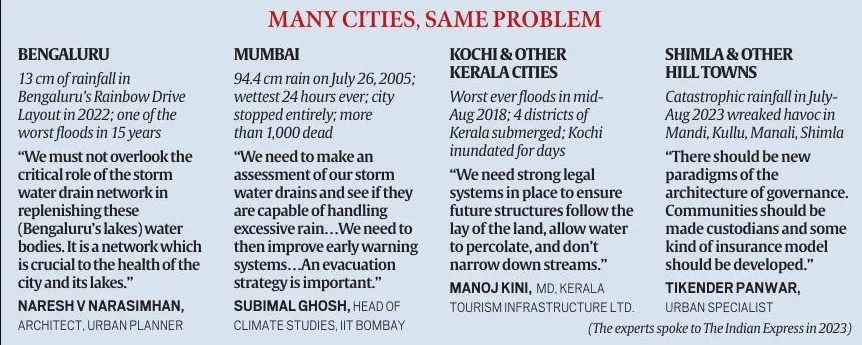Note4Students
From UPSC perspective, the following things are important :
Prelims level: Reason behind the heavy rain
Mains level: Principal Reasons Behind Chronic Urban Flooding in Delhi
Why in the news?
Heavy rain brought Delhi and NCR to a standstill, causing severe water-logging, traffic snarls, power cuts, property damage, and 11 deaths from structural collapses and electrocution.
- Climate change and rising temperatures have intensified the overflow of rivers and lakes, snowmelt, storm surges (such as hurricanes and cyclones), and abnormally heavy rains. This, coupled with locational vulnerabilities, has resulted in increased instances of urban flooding.

Principal Reasons Behind Chronic Urban Flooding in Delhi
- Unchecked Urban Expansion: Rapid, ill-planned urban growth without considering natural topography and drainage patterns.
- Inadequate Drainage Systems: Existing drainage systems are unable to handle high-intensity rainfall, leading to significant runoff.
- Concrete Overdevelopment: Excessive construction on low-lying areas and flood plains, leaving little room for water absorption.
- Destruction of Water Bodies: Reduction of water bodies that could manage floodwaters, with many converted into real estate.
- Neglect of Water in Urban Planning: Lack of a comprehensive water masterplan that integrates water management into urban development.
Present Scenario of Rapid Urbanization in Delhi NCR
- Fastest Urban Expansion: Delhi is one of the fastest-growing cities globally, with its geographic size almost doubling between 1991 and 2011.
- Population Growth: Predicted to overtake Tokyo as the world’s most populous city by 2030, with an estimated population of 39 million.
- Urban Sprawl: Expansion primarily on the peripheries, converting rural areas into urban zones, and rapid urbanization in NCR cities like Ghaziabad, Faridabad, Noida, and Gurugram.
Challenges and Limitations
- Topographical Neglect: Building in low-lying areas and on flood plains, disrupting natural drainage and increasing flood risks.
- Inadequate Infrastructure: Insufficient desilting of drains, inadequate stormwater management systems, and improper solid waste management.
- Lack of a Water Masterplan: Absence of comprehensive planning for clean and wastewater flows, leading to issues like the flooding of new infrastructures like the Pragati Maidan Tunnel.
- Reduction of green space and water bodies: Conversion of green spaces and water bodies into concrete developments, further aggravating flood situations.
- Inconsistent Urban Planning: No systematic approach to integrating natural water flows and gradients into urban development plans.
Recommendations (Way Forward)
- Integrated Urban Planning: Develop a water masterplan that prioritizes water management in urban development.
- Protection of Water Bodies: Preserve and restore existing water bodies to manage floodwaters effectively.
- Sustainable Development: Implement policies to prevent construction in low-lying and flood-prone areas.
- Infrastructure Improvement: Enhance drainage systems, desilting processes, and solid waste management to reduce water logging.
- Public Awareness: Increase awareness about the importance of sustainable urban planning and the risks of unchecked urbanization.
| Case study: Copenhagen, Denmark has an excellent “Five Finger Plan” that integrates urban infrastructure, transport, and green spaces. The city emphasizes sustainability, public life, and sensitive development. Indian Government can consider this plane. |
Mains PYQ:
Q Account for the huge flooding of million cities in India including the smart ones like Hyderabad and Pune. Suggest lasting remedial measures. (UPSC IAS/2020)
Get an IAS/IPS ranker as your 1: 1 personal mentor for UPSC 2024
